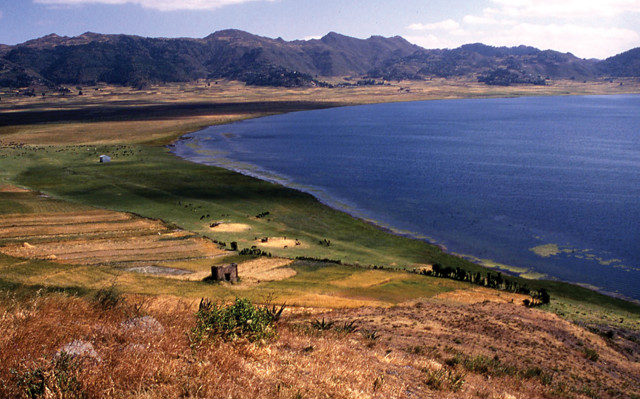
by Sarah Derouin Thursday, September 14, 2017

Scientists drilled below Lake Ashenge, on the western border of the Afar Triangle, for evidence of past eruptions. Credit: Catherine Martin-Jones.
Chains of volcanoes and a lava lake pepper the landscape of the Afar Triangle in northeastern Ethiopia, where eruptions and earthquakes are byproducts of the rifting that is literally ripping Africa apart, but recent eruptions have been docile. Now, scientists studying ash deposits from the last 40,000 years are showing that dangerous, explosive eruptions present an ongoing hazard, striking the region every 1,000 years on average.
In Ethiopia, 49 of the country’s 65 volcanoes are active, and almost half of Ethiopia’s population lives within 100 kilometers of a volcano, including the capital city Addis Ababa, which sits just over 40 kilometers from a Holocene-active volcano. Despite clear signs of geologic upheaval in the past, the volcanoes have a benign reputation, says Catherine Martin-Jones, a geochemist now at the University of Cambridge in England and lead author of the new study in Quaternary Geochronology. “Ethiopia is famous for lava lakes, but a lot of people are really surprised that you have explosive eruptions in this region,” Martin-Jones says.
Geologists have known that explosive eruptions repeatedly showered tiny volcanic ash fragments, called tephra, across the landscape during the past few million years. But without an assessment of the past tens of thousands of years, the volcanic risk today has been unclear.
To assess this shortfall, Martin-Jones and her colleagues investigated the history and tempo of explosive eruptions over the past 40,000 years in the Afar Triangle region using the glassy tephra shards, which paleontologists have long used to date hominid remains in the region. Large eruptions disperse ash across thousands of kilometers, Martin-Jones says: “It’s effectively deposited instantaneously, making these ash layers really useful time markers.”
The scientists collected tephra shards from sediments in two lakes near the Afar Triangle by drilling almost 8 meters below the lake bottoms. Each shard preserves details about the eruption that produced it, including a unique geochemical fingerprint. These shards suggested that seven different volcanoes spewed ash over the region during this period. Martin-Jones and her team then used organic material and tephras embedded in the sediments to mark the timing of eruptions using radiocarbon dating.
The results were surprising, Martin-Jones says: In the past 17,000 years, an explosive eruption struck every 1,000 years, on average. The team also noted a surge of volcanic activity between 7,500 and 1,600 years ago, when most of the tephra was deposited. The most recent eruption occurred 300 to 500 years ago, but scientists found preserved ash in sediments from one of the lakes revealing at least three eruptions in the last 1,000 years.
The study is an important first step in understanding modern volcanic hazards in Ethiopia, says Andrei Sarna-Wojcicki, a geologist at the U.S. Geological Survey in Menlo Park, Calif., who was not involved with the study. Examining the last 40,000 years is a welcome contribution, he says, since “most people have focused on eruptions near the early hominid sites, about 4 million to 1 million years ago.”
Understanding geologically recent eruptions is crucial to clarifying today’s hazards in Ethiopia, but until now, no one has looked at the record from the Holocene, says Giday WoldeGabriel, a geologist at Los Alamos National Laboratory in New Mexico who was not involved with the study. “The area is ripe for seismic and volcanic hazards,” WoldeGabriel says.
Martin-Jones and her team intend to sample sediments from more Ethiopian lakes to further refine the timing of the eruptions, which will help volcanologists refine the picture of hazards in the region.
© 2008-2021. All rights reserved. Any copying, redistribution or retransmission of any of the contents of this service without the expressed written permission of the American Geosciences Institute is expressly prohibited. Click here for all copyright requests.